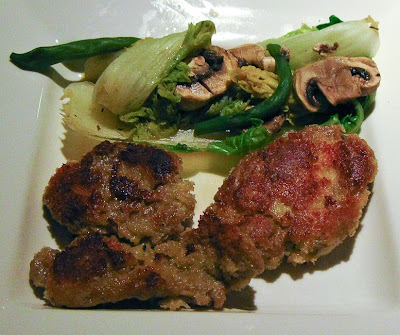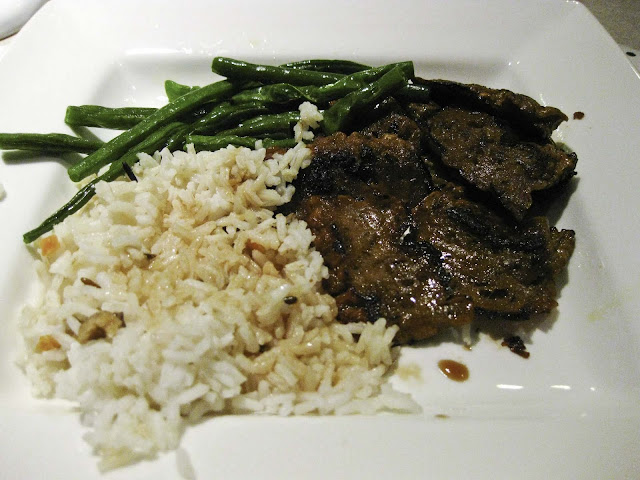Finally bought some Primal Strips from Primal Spirit Food. The texture is really about perfect. They shred nicely when pulled apart.
This is the texture I am looking for. Some are made from gluten and others from either soy or shiitake mushrooms. I like the texture but the flavors are not great. The Texas Barbecue and the Hickory Smoked flavors are more in the sauce-like coating than in the strip itself.
But who should expect real Texas BBQ flavor in a product made in Taiwan?
Here's a last-minute recipe I made up. It's not gluten but if you happen to have some textured soy protein on the shelf, this is quick and easy:
Meatless Bolognese Spaghetti Sauce
1 can diced tomatoes, unsalted, not drained
2 tsp Braggs Liquid Aminos
2 tsp Aji-Mirin (sweet Japanese cooking rice wine)
4 sliced button mushrooms
1/2 tsp garlic powder
1 tsp rubbed sage
1/2 tsp dried basil
1/2 tsp ground oregano
1/4 tsp ground savory ( had this on the shelf but never figured a use for it)
1/2 tsp dried parsley flakes
1/4 cup textured soy protein granules (available in bulk at Whole Foods)
Mix all the ingredients in a saucepan. Bring to a simmer. Simmer uncovered for about 15 minutes, until the TVP is thoroughly hydrated and the sauce has thickened. You may need to add a little water if it gets too dry and use the lid. The TVP absorbs a lot of water.
I like this recipe because it takes hardly more time than heating prepared spaghetti sauce. The TVP gives it a distinct ground beef taste and mouth feel, and also makes it a good protein source.
The Braggs Liquid Aminos is addictive. It must be high in umami, which means it must have some sort of natural MSG-like components. All taste, no guilt.
I would use fresh herbs but I just had to replant my herb Aerogarden.
If you've got no mirin handy, I would substitute any white wine but add a scant teaspoon of sugar. I know, Aji-Mirin is not the real deal but it does taste pretty good and it's easy to find.
Tuesday, May 31, 2011
Monday, May 30, 2011
Which Came First: the Chicken or the Seitan?
Making a Great Chicken Substitute
I started with Faux Chicken from VeganGuineaPig's blog. In my Cooking with Seitan cookbook, that author recommends using half soymilk, half water for the liquid mixed with the dry vital wheat gluten. I bought plain unsweetened soymilk and used about 1/2 soymilk, 2/2 water for this batch.
For some reason, I seem to need less liquid when making the gluten than most recipes call for.
With the soymilk, the finished raw gluten seemed stickier than usual. I had to wet my hands to work it. Getting stuck gluten out of the mixing bowl is always a chore. I've found soaking the bowl helps. We try to keep the gluten out of the garbage disposal as I can't imagine it gets chewed up very well.
One recipe I read called for twisting and folding the gluten as you knead it to develop "muscle" layers.
| Do this enough and you will develop new muscle layers. |
I used plenty of sage. I got genuine Albanian sage from Penzey's. Their prices are remarkably good when compared to Spice Island and McCormick at the supermarkets. Who knew Albania is known for their sage? McCormick's website has an entire page on Albanian sage.
I cut the seitan dough into smaller pieces and then stretched out those pieces to make chick'n nuggets.
| The pieces aren't that small; the bowl is huge |
I simmered it about an hour. As usual, it about doubled in size during the cook. When you first lift the lid, don't be surprised by the inflated seitan. It settles down to its resting size quickly.
| Hope it tastes better than it looks |
This batch should be easy to prepare for a meal. Yes, you have to make the seitan and then prepare it for the table. Seitan right out of the pot or steamer isn't for the uninitiated. I think I will bread and fry this batch. It's probably too healthy as is.
The finished seitan has a good texture but has a bit more brainy exterior than I hoped.
Next I breaded it with bulk breadcrumbs from our local Whole Paycheck food store and pan-fried it in about 4 tablespoons of canola oil. I braised napa cabbage and sliced button mushrooms in the broth left over from the seitan. All in all, reasonably attractive and not too bad.
 |
| Pan-fried chick'n cutlets with braised napa cabbage and mushrooms |
One caution: I didn't dry the seitan well enough before breading it. Must remember to blot surface water and squeeze out any interior water.
For the original recipe, look here. Substitute soymilk for 1/2 of the water used for mixing the vital wheat gluten. Knead by twisting and layering.
No question in my mind: Braggs Liquid Aminos has a much more desirable taste than soy sauce. I was overjoyed to see how little sodium it contains as it has no added salt per label. But then I noticed the serving size is only 1/2 tsp. It actually has more sodium than my low sodium soy sauce.
Final grade:
Taste: B+
Texture: B
Appearance: C (Still looks like seitan, not chicken)
Meat-like shredding: C-
Sunday, May 29, 2011
The Quest for the Perfect Seitan
On Thanksgiving Day 2009, my family and I finished our Thanksgiving dinner. After finishing my turkey, I decided to become a vegetarian. We sent the leftover turkey home with a relative. I haven't eaten meat since.
I discovered life as a vegetarian isn't as simple as I thought. I always thought it was as simple as just leaving off the meat and eating everything else. Not so. While the need for quality protein isn't as great as some think, a good meat substitute would provide extra protein and also provide some dental exercise.
I found textured soy protein in granules and chunks. Done right, it's a pretty good meat imitation, both in taste and mouth feel. But there's the matter of phytoestrogens in soy, something to consider when eating a lot of it.
Seitan is a meatlike product made from vital gluten flour, a wheat flour processed to remove starch, leaving it better than half protein. Fortunately I don't have any problem with gluten intolerance or sensitivity. For those with that problem, stop reading here and find a soy blog.
For the past year, I've been looking for the perfect seitan recipe. Here are my ideal qualifications. The Seitan should:
- have the flavor of beef, pork, lamb or chicken.
- have the mouth feel and texture of meat.
- shred like meat. Think of how chicken breast shreds when you pull it apart with a fork.
- be relatively low in sodium.
- be relatively inexpensive.
- taste reasonably good without having to bread and fry it.
I've prepared it by simmering, boiling, steaming, baking and crockpotting. I've gotten reasonably good tasting seitan and a pretty decent texture, but sadly, never both in a single batch.
Texture is critical. Seitan can be rubbery to the point it doesn't shred but just cracks when pulled apart with forks. At its worst, your teeth sort of squeak as you bite through it. That's unacceptable.
At the other end of the spectrum, it can be soft and crumbly. I've made seitan with an uncanny resemblance to a matzoh ball. No meaty gratification with that batch.
One recipe says to knead the gluten a lot to develop a shredding texture. Another says just mix and don't knead or you'll get rubbery seitan. Yet another recipe claims that adding garbanzo bean flour or soy is the key. One says boil, another says simmer. Add ginger. Don't add ginger. The recommendations are endless.
Seitan prepared teriyaki-style with rice and green beans. I got the look of meat but not quite the taste of beef. But your eyes do say "meat" with this one. Marinating in mirin before pan-grilling in a little canola oil developed the beefy "char" appearance.
These pages will tell the story of my quest for the perfect seitan.
Subscribe to:
Posts (Atom)


